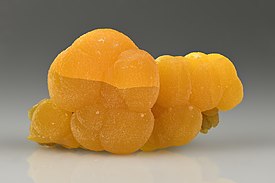Mimetite is a lead arsenate chloride mineral (Pb5(AsO4)3Cl) which forms as a secondary mineral in lead deposits, usually by the oxidation of galena and arsenopyrite. The name derives from the Greek Μιμητής mimetes, meaning "imitator" and refers to mimetite's resemblance to the mineral pyromorphite. This resemblance is not coincidental, as mimetite forms a mineral series with pyromorphite (Pb5(PO4)3Cl) and with vanadinite (Pb5(VO4)3Cl). Notable occurrences are Mapimi, Durango, Mexico and Tsumeb, Namibia.
| Mimetite | |
|---|---|
 Golden yellow botryoidal mimetite from Congreso-León mines, Mexico | |
| General | |
| Category | Arsenate minerals Apatite group |
| Formula (repeating unit) | Pb5(AsO4)3Cl |
| IMA symbol | Mim[1] |
| Strunz classification | 8.BN.05 |
| Crystal system | Hexagonal |
| Crystal class | Dipyramidal (6/m) (same H-M symbol) |
| Space group | P63/m |
| Unit cell | a = 10.250(2) Å, c = 7.454(1) Å; Z = 2 |
| Identification | |
| Color | Pale to bright yellow, yellowish brown, yellow-orange, white, may be colorless |
| Crystal habit | Prismatic to acicular crystals; reniform, botryoidal, globular, |
| Twinning | Rare on {1122} |
| Cleavage | [1011] Imperfect |
| Fracture | Brittle, conchoidal |
| Tenacity | Brittle |
| Mohs scale hardness | 3.5–4 |
| Luster | Resinous, subadamantine |
| Streak | White |
| Diaphaneity | Transparent to translucent |
| Specific gravity | 7.1–7.24 |
| Optical properties | Uniaxial (−), anomalously biaxial |
| Refractive index | nω = 2.147 nε = 2.128 |
| Birefringence | 0.019 |
| Pleochroism | Weak |
| References | [2][3][4] |
Properties
editMimetite is a lead chloride arsenate mineral with the composition Pb5(AsO4)3Cl. It is a secondary mineral, formed by oxidation of primary lead minerals in arsenic-bearing lead deposits.[2] It typically forms short hexagonal crystals that are yellow to brown to orange in color, very brittle, moderately hard (Mohs hardness 3.5–4), and dense (specific gravity 7.24). It is distinctive for its lack of transparency, its resinous to adamantine luster, and its solubility in nitric acid.[5]
Mimetite forms a complete solid solution series with pyromorphite, with phosphate (PO3−
4) substituting for arsenate (AsO3−
4). The two minerals are almost identical in their properties and can be difficult to distinguish except by laboratory tests. Pyromorphite is the more common mineral at most locales.[5]
Campylite is a name applied to mimetite or pyromorphite that crystallizes as distinctive barrel-shaped crystals forming curved hemispherical aggregates.[5] Bellite is a name formerly applied to a chromium-bearing mimetite, or possibly a mixture of crocoite, mimetite and quartz, which forms attractive orange red crystals, but has been discredited as a distinct mineral species.[6]
Occurrences
editMimetite is found in association with lead and arsenic minerals, including pyromorphite, cerussite, hemimorphite, smithsonite, vanadinite, anglesite, pyrite, mottramite, willemite, and wulfenite.[5][2] Good specimens have been reported from Gila County, Arizona, US; Ojocaliente, Zacatecas, Mexico; Cumberland, England; Johanngeorgenstadt, Saxony, Germany; Namibia; and Broken Hill, Australia.[5]
Mimetite specimen gallery
edit-
Mimetite from Tsumeb Mine, Namibia
-
Cluster of translucent, golden mimetite crystals
-
Spherical aggregates of botryoidal mimetite
-
Mimetite, Pingtouling Mine, Guangdong Province, China. Size: 2.2 x 2.1 x 1.8 cm
References
edit- ^ Warr, L.N. (2021). "IMA–CNMNC approved mineral symbols". Mineralogical Magazine. 85 (3): 291–320. Bibcode:2021MinM...85..291W. doi:10.1180/mgm.2021.43. S2CID 235729616.
- ^ a b c Anthony, John W.; Bideaux, Richard A.; Bladh, Kenneth W.; Nichols, Monte C. (eds.). Handbook of Mineralogy (PDF). Chantilly, VA 20151-1110, US: Mineralogical Society of America. Retrieved 12 February 2022.
{{cite book}}: CS1 maint: location (link) - ^ Mimetite, Mindat.org, retrieved 12 February 2021
- ^ Barthelmy, David (2014). "Mimetite Mineral Data". Mineralogy Database. Webmineral.com. Retrieved 12 February 2022.
- ^ a b c d e Sinkankas, John (1964). Mineralogy for amateurs. Princeton, N.J.: Van Nostrand. pp. 419–422. ISBN 0442276249.
- ^ Burke, E.A.J. (2006). "A mass discreditation of GQN minerals". The Canadian Mineralogist. 44 (6): 1557–1560. Bibcode:2006CaMin..44.1557B. doi:10.2113/gscanmin.44.6.1557.
External links
edit- . Encyclopædia Britannica. Vol. 18 (11th ed.). 1911.
- Mineral Galleries